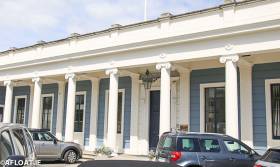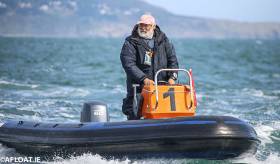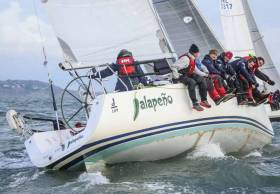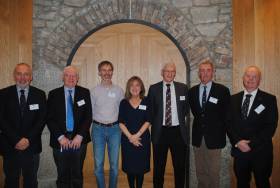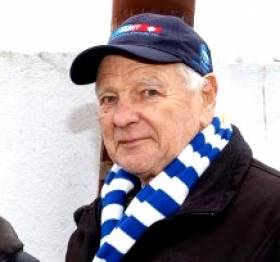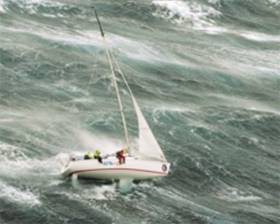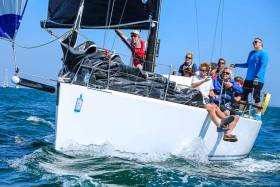Displaying items by tag: Royal Irish Yacht Club
Changes on the Dun Laoghaire waterfront this season include a makeover to one of the most impressive facades in the centre of the harbour.
Few institutions surviving from the 1800s are older than the Royal Irish Yacht Club but this season in a move away from its traditional cream-coloured facade the oldest club in the harbour is sporting a new paint job, just in time for next month's Volvo Dun Laoghaire Regatta when the harbour will be en fete to welcome 3,000 sailors to the town.
As Afloat's WM Nixon previously reported here, the RIYC’s beautiful building is the world’s oldest purpose-built sailing clubhouse still precisely intact as originally designed completed in 1851 to the plans of John Skipton Mulvany and there’s no denying the sense of history kept alive with its elegant interior and impressive exterior.
This season the listed clubhouse, that retains to this day all its original architectural features, has opted for a discreet combination of light blue on the inner walls of the front facade with cream columns and a dark blue for the wooden sash windows, creating a greater sense of depth to the facade. Mr. Skipton would approve, surely?
Other decor projects on the waterfront are also underway. Starting into the scraping and painting routine (see below) is the Royal St. George Yacht Club. What colour are they going for?
 Work is underway on a new paint job at The Royal St George Yacht Club Photo: Afloat.ie
Work is underway on a new paint job at The Royal St George Yacht Club Photo: Afloat.ie
The Royal Irish Yacht Club in Dun Laoghaire is hosting an interactive session with Dublin Bay-based international race judge Gordon Davies on how you can best use the racing rules to your advantage.
The rule guru and international jury chairman will be on hand to answer your questions and give you plenty of insight into the world of racing rules.
The event will start this Wednesday at 1900 hrs in the RIYC Wet Bar. All are welcome but you must register here to attend, according to the RIYC website.
The running order for the talk will be:
- Right of Way at the Start line
- Room and Right of Way at the Windward Mark
- Room and right of Way at the Leeward Mark
J109 Jalapeno Wins Royal Irish Yacht Club Charity Race
There were 20 entries in a light southwesterly breeze for the Royal Irish Yacht Club's Annual Charity Race on Sunday, 30th December 2018
Race officers Henry Leonard and Paul McCarthy laid a triangle/sausage/ triangle course which was completed in an hours racing.
Line honours and the race win went to Jalapeño from the National Yacht Club helmed by Paul Barrington.
Second was another J109, Dear Prudence and third the J122 Gib & Tonic.
Just under €2000 was raised on the day for the RNLI.
Royal Irish Yacht Club Charity Race for December 30th on Dublin Bay
The Royal Irish Yacht Club will hold its Annual Charity Race on Sunday 30th December 2018
In aid of the RNLI Lifeboat Service, the warning signal for the keelboat race is 10.55.
Prizes will be awarded to first, second and third subject to entry numbers and be presented in the RIYC wet bar après sail where a hot dish will be available for all at €10 per serving.
Download the NOR below
Weather & Sailing Conference Attracts A Big Crowd at Royal Irish Yacht Club
The day-long Weather and Sailing Conference at the Royal Irish Yacht Club in Dun Laoghaire today is the first of its kind to be held in Ireland.
Attracting a large audience, the line-up of speakers at the yacht club draws on highly-qualified experts from both sides of the Irish Sea, and though much of the emphasis will be on weather conditions in Ireland, the conference is notably broad in its scope and variety of topics.
As Afloat.ie previously reported, the conference, organised by the Royal Institute of Navigation ( RIN) and the Irish Meteorological Society ( IMS) is supported by Dublin Port Company and runs until 5.30pm.
 A large gathering for today's Weather Conference at the RIYC in Dun Laoghaire
A large gathering for today's Weather Conference at the RIYC in Dun Laoghaire
Fred Espey 1934-2018
Fred Espey of Dun Laoghaire, who has died aged 85, was best-known in sailing as Commodore of the Royal Irish Yacht Club from 2001 to 2004, the culmination of many years of service to the club in a variety of roles. Yet while his quiet-spoken charm and ready hospitality enabled him to fulfil the demanding role of Commodore with the complete support of his wife Eileen, these official duties only temporarily obscured the fact he was very much a man of the Dun Laoghaire waterfront, enjoying the company of others who, like himself, were proficient in the ways of boats and their equipment, and in the skills of the sea.
Although the family home of his boyhood was in Dublin where Ringsend is verging into Ballsbridge and he went to school in St Andrew’s, he lived for the summers spent in Dun Laoghaire with relatives whose house was next door to the legendary “gentleman boatbuilder” Skee Gray. In Skee’s workshop, young Fred was soon acquiring boatbuilding skills which he continued to practice for much of his long life.
The first boat he owned was the Water Wag Phyllis, his ownership being possible as she was bought in a near-derelict state. With Skee Gray’s training, he was able to make her good as new. Then in the early 1960s he turned his attention to the very neglected 17-footer Rosemary which Buddy Thompson – who was noted for sailing bare-footed in a bowler hat and with his toenails painted red for regattas – had not sailed for many years.
It took some time to extract Rosemary from her eccentric owner, but then a winter of work in the Coal Harbour Boatyard by Fred and some friends brought her back to pristine condition in what was effectively a re-build, and he was so fond of his little keelboat that he kept her even when all the other Seventeens had long since ceased to be DBSC 17s, having crossed Dublin Bay to return to being Howth 17s.
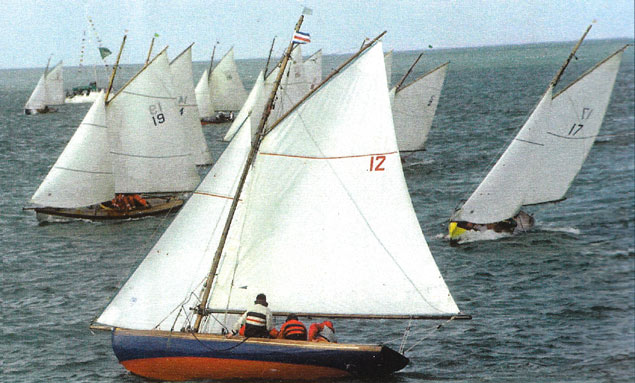 The 17-Footer Rosemary, originally built in 1907 by James Kelly of Portrush, which Fred Espey personally re-built in the early 1960s. It was his second re-build – he’d already completed a successful project on a Water Wag. And it wasn’t until 1971 that Rosemary – the last 17-footer in Dun Laoghaire – was finally sold by him across Dublin Bay to join her sisters in Howth. Photo courtesy Howth 17-Footer Assoc.
The 17-Footer Rosemary, originally built in 1907 by James Kelly of Portrush, which Fred Espey personally re-built in the early 1960s. It was his second re-build – he’d already completed a successful project on a Water Wag. And it wasn’t until 1971 that Rosemary – the last 17-footer in Dun Laoghaire – was finally sold by him across Dublin Bay to join her sisters in Howth. Photo courtesy Howth 17-Footer Assoc.
Finally, in 1971 he sold Rosemary to Howthmen George Curley and Davy Jones, who still own her. But back in Dun Laoghaire which was now his home, Fred Espey had been making preparations for married life with Eileen McNulty by ensuring that, three weeks before the wedding, he acquired the little gaff cutter Jem, which he moored off the Royal Irish YC. He liked the reassurance of having his own boat, particularly in the face of impending domesticity, but in truth he was so able in a boat that he could get sailing in a variety of craft any time he liked, and for some time he had been a regular crewman aboard Punctilio, the last Dublin Bay 25 to be based in Dun Laoghaire. To balance that, his first excursion into Bermudan-rigged ownership was with several years of DBSC racing with the wooden International Dragon Ariadne.
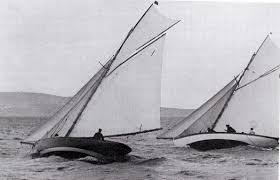 The Dublin Bay 25s – established 1898 – in their racing prime. Among Fred Espey’s many sailing experiences was a regular crewing position aboard W B Stephen’s Punctilio, the last DB 25 to be based in Dublin Bay. Photo courtesy DBSC
The Dublin Bay 25s – established 1898 – in their racing prime. Among Fred Espey’s many sailing experiences was a regular crewing position aboard W B Stephen’s Punctilio, the last DB 25 to be based in Dublin Bay. Photo courtesy DBSC
He enjoyed being in the sea as much as being on it, and for many decades he was a daily swimmer at the Forty Foot - at the time of his death, he was President and Chairman of the 1890-established Sandycove Bathers Association, and had been for many years. But being Fred Espey, he carried this interest in swimming a stage further by developing proficiency in diving, so much so that it was he who discovered the giant anchor on the seabed of Dun Laoghaire Harbour which was lifted by Paddy Murphy, boatman at the RIYC, and is now on permanent display at the National Maritime Museum.
His professional career was in the marketing of animal feeds, a job which meant that outside work, he returned to boats and the sea with even more enthusiasm. He always seemed to have several boat-related projects on the go at one time, and in 1964 when Paul Campbell’s lovely Arthur Robb-designed yawl Verve was under construction with Tyrrell’s of Arklow to be the special boat for the yard’s centenary that year, it was Fred Espey who was asked to be Owner’s Representative throughout the building.
 The classic Arthur Robb yawl Verve in Autumn sunshine in Dublin Bay. In 1964, Fred Espey was Owner’s Representative during the building of Verve to become the Centenary Boat at Tyrrell’s of Arklow
The classic Arthur Robb yawl Verve in Autumn sunshine in Dublin Bay. In 1964, Fred Espey was Owner’s Representative during the building of Verve to become the Centenary Boat at Tyrrell’s of Arklow
Then when the much-travelled Verve was completed and cruising extensively, Fred’s quietly reassuring presence, the epitome of able seamanship, was always welcome on board, and he was elected a member of the Irish Cruising Club in 1978. Aboard Verve, another regular crewmember was James Osborne, and when Paul Campbell finally relinquished Verve, he left her to the Espey/Osborne partnership which throve happily for many years and then expanded with extra members such as Michael Boyd to take on the handsome Bowman 46 Hibernia, whose cruises included a Transatlantic passage with Fred Espey in command.
The breadth of his knowledge of boats and how they function was further demonstrated when Dublin Bay SC decided to take a pioneering step in acquiring a catamaran for their Committee Boat. This in time became Mac Lir, and one of the prime movers in the project, Fintan Cairns, recalls that a first port of call for advice was an informative and detailed conversation with his friend Fred Espey.
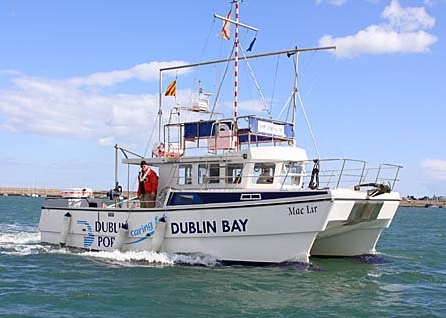 When Dublin Bay SC decided to develop the then-revolutionary concept of a catamaran Committee Boat, one of the first people they turned to for technical advice on the boat which eventually became Mac Lir was Fred Espey. Photo courtesy DBSC
When Dublin Bay SC decided to develop the then-revolutionary concept of a catamaran Committee Boat, one of the first people they turned to for technical advice on the boat which eventually became Mac Lir was Fred Espey. Photo courtesy DBSC
He retired from the animal feeds business while still young enough to develop his interest in diving into an underwater contracts business, but as ever there were unexpected spinoffs. One day in checking moorings in Dun Laoghaire Harbour, he discovered the long-sunken hull of a 19ft Squib keelboat. Nobody was interested in claiming it, so in his spare time, he renovated it completely and then assembled a rig from the remains of a broken Dragon mast.
It says everything about Fred Espey’s continuing joy in sailing that if a free day happened to come long, he’d sail this rescued boat single-handed if needs be, but if a shipmate such as Peter Fleming were available, they’d pop down the coast to Bray for a spot of lunch in the Harbour Bar and sail back up again, marvelling anew that there was such a magnificent coastline right on the doorstep of the city.
But he was by no means a stay-at-home sailor, and when clubmates Bob and Barbara Stewart bought the extremely elegant Alden 54 Tara, they ensured that Fred Espey was on board as often as possible and frequently for very long voyages, for the sea and sailing really were in his blood.
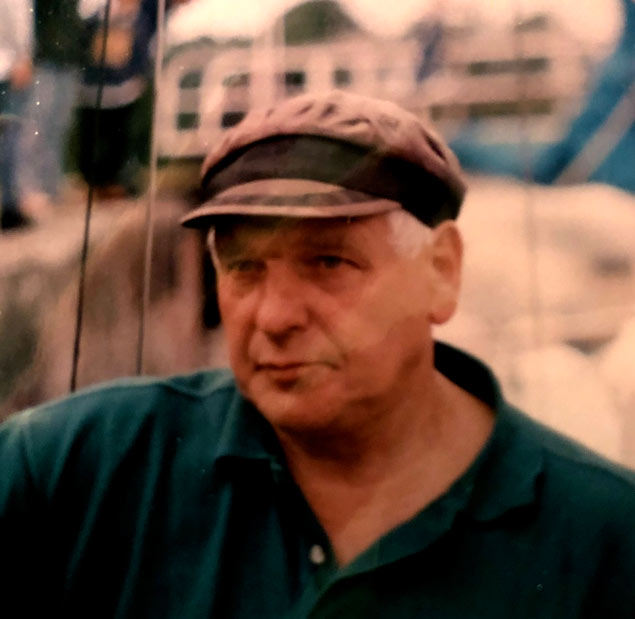 A man absorbed in his work. Fred Espey steering Hibernia into a lock chamber in the Caledonian Canal. Photo: Peter Fleming
A man absorbed in his work. Fred Espey steering Hibernia into a lock chamber in the Caledonian Canal. Photo: Peter Fleming
It was a passion which he has passed down the generations, as his eldest son David is one of the leading figures in the Classic Yachts movement, both in Dublin Bay and internationally. He and his siblings Alan and Helen have also seen the loss of their mother Eileen two-and-a-half years ago. Our heartfelt condolences are with them at this sad time and with Fred Espey’s ten grandchildren and his recently-arrived great-grandson James.
In his quiet yet determined way, Fred Espey was a very special one-off, and he will be much missed by his many friends in the sailing community.
WMN
Weather & Sailing Conference Will Provide Answers for Irish Boat Enthusiasts
Ireland’s weather fascinates everyone. But for boat enthusiasts, an informed insight into the workings of maritime meteorology anywhere in the world has many practical and often vital applications writes W M Nixon. With this in mind, Darryl Hughes (best known as owner-skipper of the superbly-restored classic Tyrrell of Arklow-built ketch Maybird) had donned his other hat as co-ordinator of the Royal Institute of Navigation’s Small Craft Group, and together with the Irish Meteorological Society with sponsorship by Dublin Port Company, he is organising a day-long Weather & Sailing Conference at the Royal Irish Yacht Club in Dun Laoghaire on Friday November 23rd 2018 from 9.00am until 5.30pm.
The line-up of speakers draws on highly-qualified experts from both sides of the Irish Sea, and though much of the emphasis will be on weather conditions in Ireland, the conference is notably broad in its scope and variety of topics. Thus while we’ll have Evelyn Cusack of Met Eireann and current Sailor of the Year Conor Fogerty to provide two complementary views of marine meteorology, we’ll also have specialists such as Jessica Sweeney who is lead met adviser to the Ineos Americas Cup Challenge, and Dag Pike who has been navigator to several successful major transoceanic record challenges.
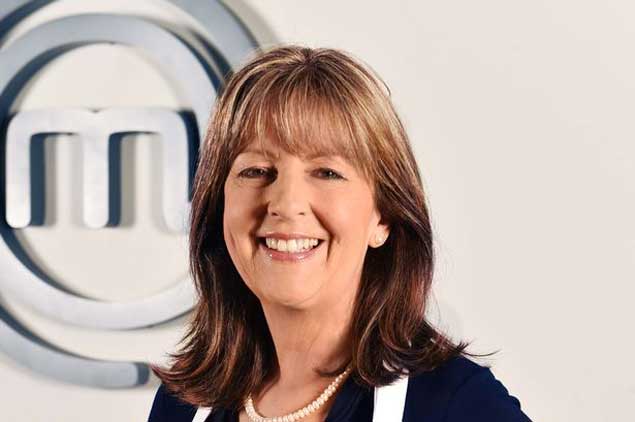 Evelyn Cusack of Met Eireann will be among the speakers
Evelyn Cusack of Met Eireann will be among the speakers
WEATHER & SAILING CONFERENCE (IMS & RIN) Royal Irish YC Dun Laoghaire, Friday 23rd November 2018
SPEAKERS & TOPICS
EVELYN CUSACK (Met Eireann) “Exactly How Do We Forecast The Weather”
CONOR FOGERTY (Sailor) “Weather & The Single-Hander : The 2017 OSTAR”
RICHARD FALK (RYA) “A Glimpse Into Weather and Navigational Challenges of the Sydney-Hobart Race”
CHRISTIAN DUMARD (Professional Sailor) “Squib Software and Weather Routing for the Volvo Fleet”
CAPT. ROBERT McCABE (Irish Lights) “The Met Ocean Data Buoys Project”
CAPT. COLM NEWPORT (Dublin Port) “Weather and the Dublin Port Pilot”
JESSICA SWEENEY (Team Ineos UK) “Weather and the America’s Cup”
DAG PIKE (Tactician & Maritime Journalist) “Weather Forecasting for Breaking Records”
LIBBY GREENHALGH (Professional Sailor) “Weather and the 2017/2018 Volvo Race”
Booking for the Conference is open to all on a first come, first served basis, and the fee of €30 includes lunch in the RIYC. Details for registering here
 OSTAR 2017 winner Conor Fogerty will be drawing on his intense experience of getting on the winning side of an extreme Atlantic storm
OSTAR 2017 winner Conor Fogerty will be drawing on his intense experience of getting on the winning side of an extreme Atlantic storm
Royal Irish Yacht Club Hosts Beneteau 31.7 National Championships
Jean Mitton's Levana of the Royal St. George Yacht Club will defend her Beneteau 31.7 National Championship title at the Royal Irish Yacht Club this weekend on Dublin Bay.
An expected 13-boat fleet will race a six race series. Four on Saturday and two on Sunday.
Prizes shall be awarded to the first three boats in Scratch and Handicap divisions.
Perpetual Trophies shall be presented to the winners in Scratch and Handicap divisions.
Download NOR below
Big Turnout for Royal Irish Yacht Club Regatta as New Sponsor Unveiled. Results & Photos Here!
2018 marked a big year for the Royal Irish Yacht Club's Regatta with the announcement that Drumshanbo Gunpowder Irish Gin has come aboard as title sponsor of the event, a shot in the arm for the waterfront regatta scene at Dun Laoghaire.
The spectacle kicked off yesterday at 11.30 in ideal conditions and, as Afloat.ie reported previously, the one-day regatta saw a combined fleet of approximately 160–yachts across 20 classes compete in the popular two-race format.
Download full results from all classes below
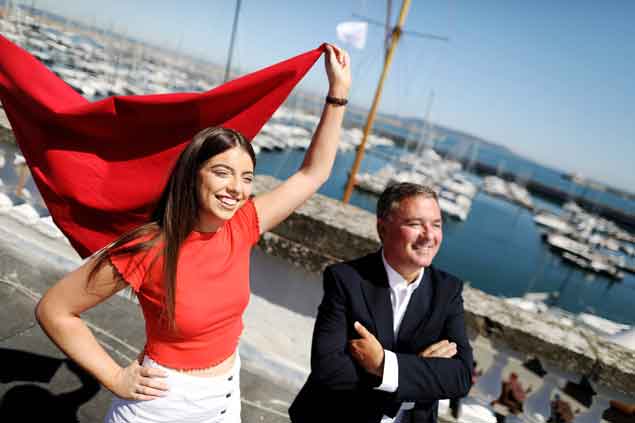 The sun shines on Roisin Rigney and Padraig McCarthy (CEO Royal Irish Yacht Club) at the Drumshanbo Gunpowder Irish Gin Royal Irish Yacht Club Regatta. Photo: Julien Behal
The sun shines on Roisin Rigney and Padraig McCarthy (CEO Royal Irish Yacht Club) at the Drumshanbo Gunpowder Irish Gin Royal Irish Yacht Club Regatta. Photo: Julien Behal
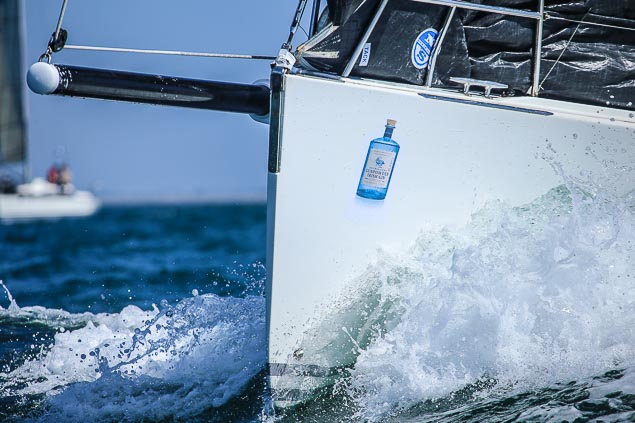 The new sponsor's bottle was on the bows of 160 boats Photo: Afloat.ie
The new sponsor's bottle was on the bows of 160 boats Photo: Afloat.ie
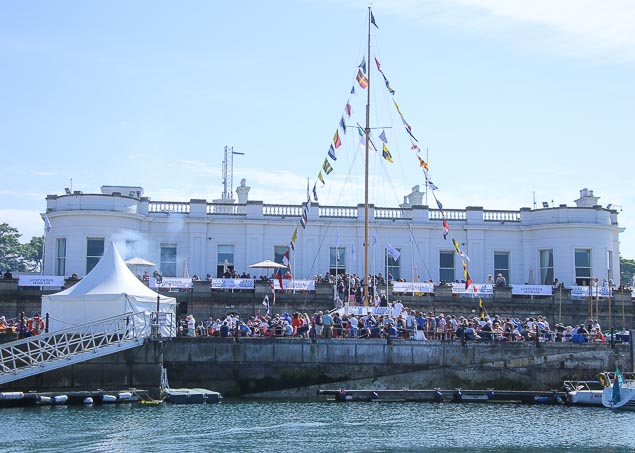 The Royal Irish was thronged with sailors and families for yesterday's Regatta Photo: Afloat.ie
The Royal Irish was thronged with sailors and families for yesterday's Regatta Photo: Afloat.ie
A 12-14–knot northeasterly gradient produced T-shirts and shorts sailing conditions for most crews in the cruiser classes and for some of the one design classes too as the heatwave over Ireland continues.
In a unique double for the club, it co-hosted the staging of the Round Ireland Race from Wicklow while staging its club regatta on the same day. It was quite an achievement which it pulled off in style, even though some of the RIYC's own big boats were unable to participate in the regatta due to their Round Ireland commitments off Wicklow including former ICRA Boat of the Year, the George Sisk skippered Farr 42 Wow and the Dun Laoghaire Dingle Race Champion, Rockabill VI (Paul O'Higgins).
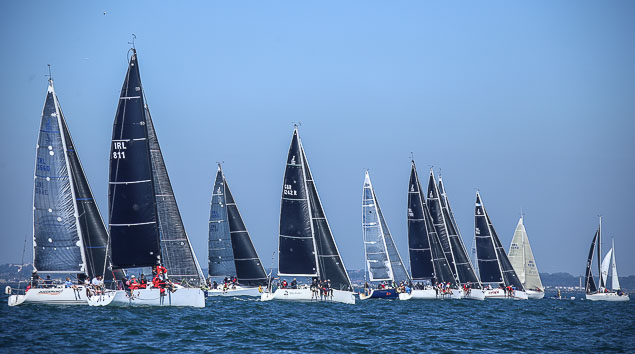 A fine cruiser one start of the first race Photo: Afloat.ie
A fine cruiser one start of the first race Photo: Afloat.ie
 Greystones based Grand Soleil 44 Eleuthera was the class zero winner Photo: Afloat.ie
Greystones based Grand Soleil 44 Eleuthera was the class zero winner Photo: Afloat.ie
In class zero, a three–boat dogfight produced a win for Greystones Harbour's Eleuthera from Paddy McSwiney's D Tox. It is the second win of the season for the Wicklow boat skippered by Frank Whelan who has also chalked up early coastal success racing in the Viking Marine sponsored ISORA fleet race in May.
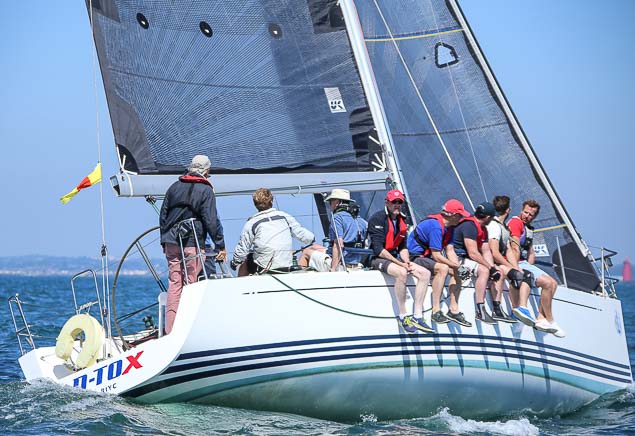 Paddy McSwiney's X35 D Tox was second in class zero Photo: Afloat.ie
Paddy McSwiney's X35 D Tox was second in class zero Photo: Afloat.ie
There was some upset to the pecking order in class one IRC when Andrew Algeo's J109 Juggerknot who has enjoyed a string of wins since May had to settle for fourth in his own club's regatta. It was Algeo's clubmates Tim and Richard Goodbody in their J109 White Mischief who took the honours in the impressive 16–boat fleet. In second place was another J109, Brian and John Hall's Something Else from the National Yacht Club, with another NYC J boat, Jalapeno from the RStGYC third.
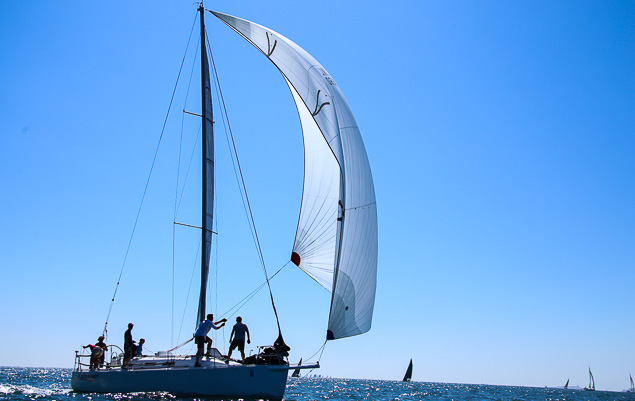 Perfect sailing conditions for the RIYC regatta Photo: Afloat.ie
Perfect sailing conditions for the RIYC regatta Photo: Afloat.ie
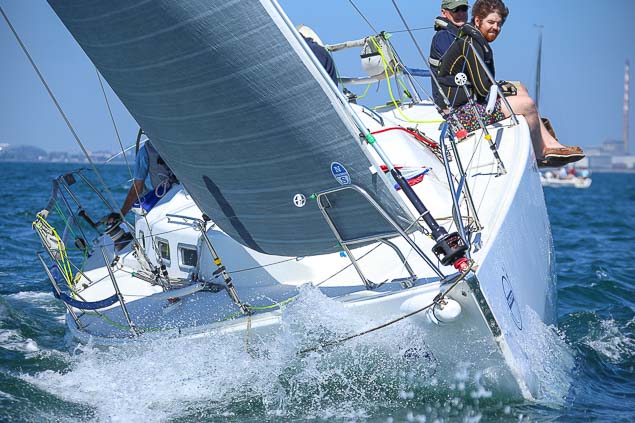 Paul Barrington's J109 Jalapeno was third in class one IRC
Paul Barrington's J109 Jalapeno was third in class one IRC
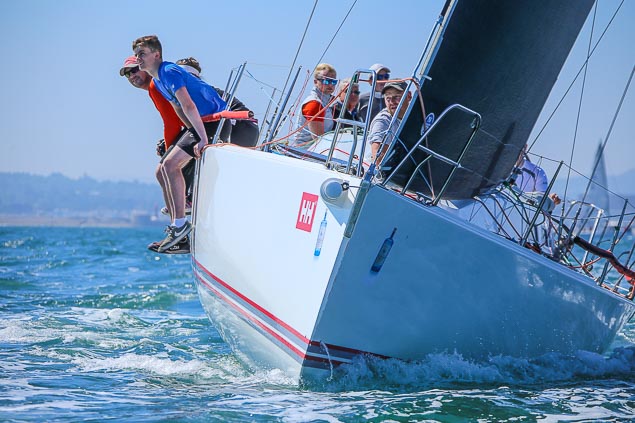 Howth J109 Storm Photo: Afloat.ie
Howth J109 Storm Photo: Afloat.ie
In a fine 15–boat class two turnout, there is still no breaking the stranglehold of the optimised Half Tonners from Howth. Dave Cullen's Checkmate XV again won with two wins from Jonny Swan's Harmony. Third was Nigel Biggs' Checkmate XVIII. Anthony Gore-Grimes' Dux, an X332 was fourth with Dick Lovegrove's Sigma 33 fifth on IRC.
 Jonny Swan's Half Tonner Harmony from Howth was second overall Photo: Afloat.ie
Jonny Swan's Half Tonner Harmony from Howth was second overall Photo: Afloat.ie
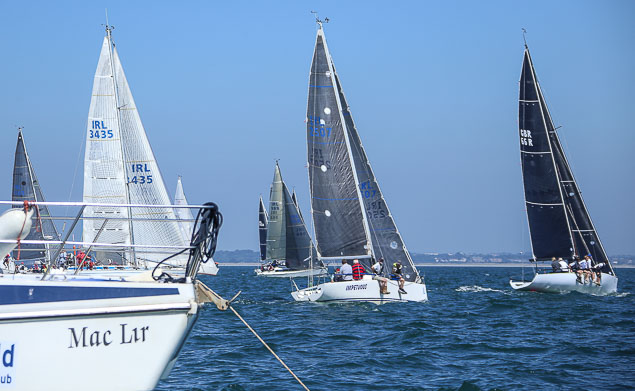 Nigel Biggs' Checkmate XVIII makes a great start in race one Photo: Afloat.ie
Nigel Biggs' Checkmate XVIII makes a great start in race one Photo: Afloat.ie
There were notable exceptions from some of the one design fleets such as the SB20s who were racing separately for national championship honours.
The Flying Fifteens turned out in double figures but some of their number were competing at the weather–hit British National Championships in Strangford Lough, including Bay Champions David Gorman and Chris Doorly who took fourth overall in County Down. David and Conor Mulvin beat a ten–boat fleet to win from National Yacht club mate Joe Coughlan. Third was another NYC skipper, Peter Murphy.
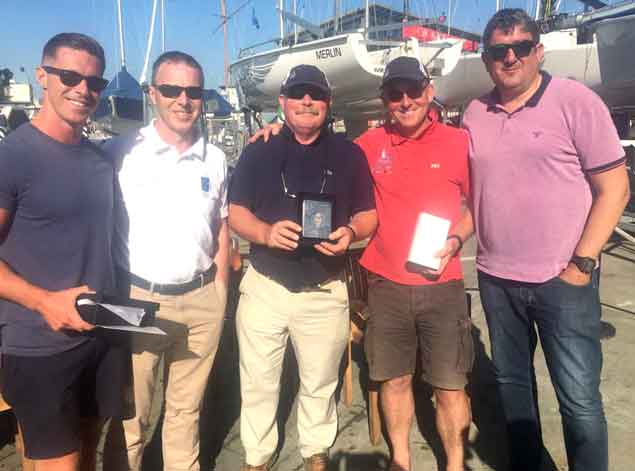 Flying fifteen winners at the RIYC prizegiving - Left to right: First overall Conor & David Mulvin, second Joe Coughlan and third Peter Murphy and Andy Marshall
Flying fifteen winners at the RIYC prizegiving - Left to right: First overall Conor & David Mulvin, second Joe Coughlan and third Peter Murphy and Andy Marshall
In the Dragon class, a turnout of five was reduced by one at least with the absence of Martin Byrne's Jaguar that is competing at the Edinburgh Cup in Torbay.
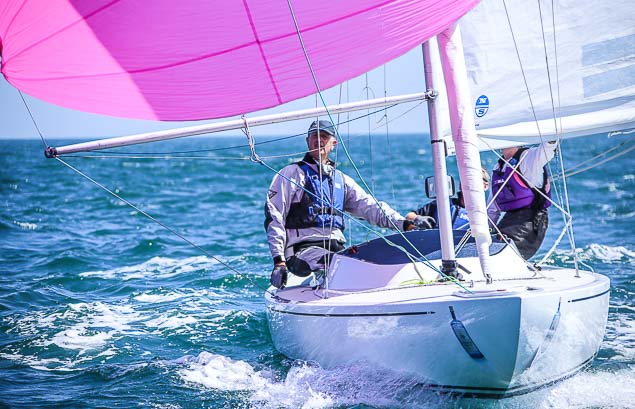 Peter Bowing's Phantom from the Royal St. George Photo: Afloat.ie
Peter Bowing's Phantom from the Royal St. George Photo: Afloat.ie
Likewise, a conflicting Squib event in Kinsale reduced the fleet to only three. Periquin was first with Fox second and Allsorts third.
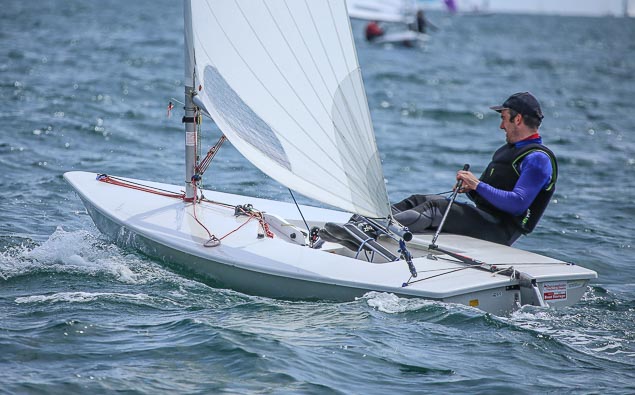 Ronan Wallace was the Laser class winner Photo: Afloat.ie
Ronan Wallace was the Laser class winner Photo: Afloat.ie
In the dinghy classes, Ronan Wallace was the winner in the Laser class, with a two and a one scored ahead of Royal St. George's Ross O'Leary in second with Eoin Delap third. Wallace adds this win to last week's NYC Regatta victory to go top in the new Dublin Bay Regatta Laser League. In the six-boat Radial division, the National Yacht Club's Ella Hemeryck beat men's national champion Sean Craig of the Royal St. George Yacht Club.
 Ruffian 23 Bandit from the National Yacht Club
Ruffian 23 Bandit from the National Yacht Club
In the Ruffian 23 class, Frank Bradley sailing Ripples beat Michael Cutliffe's Ruffles from the DMYC with Ann Kirwan's Bandit from the National Yacht Club in third.
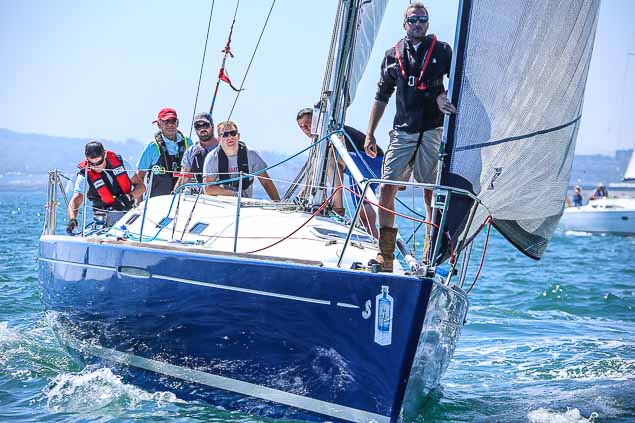 Chris Johnston's Beneteau 31.7 Prospect was the class winner Photo: Afloat.ie
Chris Johnston's Beneteau 31.7 Prospect was the class winner Photo: Afloat.ie
In a fine turnout of 13 entries for the mixed Sportsboats class, Howth Yacht Club visitors carried the day with Dan O'Grady's Jammy and Nobby Reilly's Red Cloud first and second. The host club's Mervyn Dyke was third.
 Howth's Dan O'Grady was the Sportsboat winner in the J80 Jammy Photo: Afloat.ie
Howth's Dan O'Grady was the Sportsboat winner in the J80 Jammy Photo: Afloat.ie
Download full results from all classes below
Royal Irish Yacht Club Regatta & Round Ireland Race will See Good Saturday Sailing with Sunny Sea Breezes
The stately Royal Irish Yacht Club is in busy form these days writes W M Nixon. Yesterday evening (Wednesday), Commodore Joe Costello hosted a reception to give a fair wind to the sponsorship by Drumshanbo Gunpowder Irish Gin of this Saturday’s RIYC Annual Regatta, a sailfest which bids fair to be favoured by a summery sea breeze and sunshine. And at the same time, several of the club’s most noted offshore racers were gearing themselves up for this Saturday’s other major event, the Volvo Round Ireland Race from Wicklow, starting 2.0pm Saturday.
 Inundated in Optimism…..the Royal Irish Yacht Club in full junior sailing mode with Optimists every which way. This Saturday, the club is in classic colourful style, hosting its Drumshanbo Gunpowder Irish Gin-sponsored Annual Regatta while at the same time sending off the largest club contingent in the biennial Volvo Round Ireland race from Wicklow.
Inundated in Optimism…..the Royal Irish Yacht Club in full junior sailing mode with Optimists every which way. This Saturday, the club is in classic colourful style, hosting its Drumshanbo Gunpowder Irish Gin-sponsored Annual Regatta while at the same time sending off the largest club contingent in the biennial Volvo Round Ireland race from Wicklow.
 Mark McGibney, RIYC sailing services manager and Miguel Walker, RIYC bosun and (below) guests at the pre-regatta reception
Mark McGibney, RIYC sailing services manager and Miguel Walker, RIYC bosun and (below) guests at the pre-regatta reception
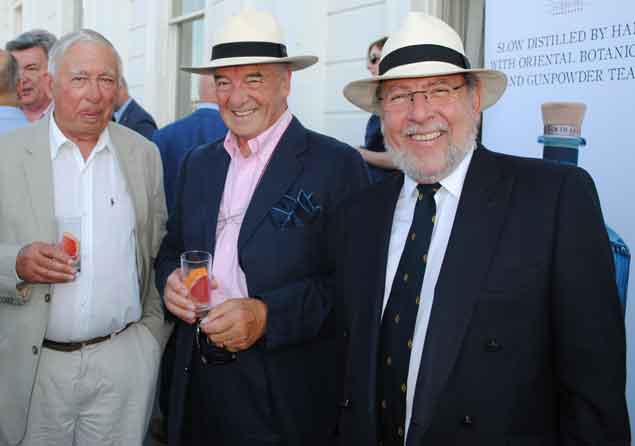 Terence Brien, Garry Fleming and James Horan
Terence Brien, Garry Fleming and James Horan
 Charlotte Norwood, Ita Benedetti, Alan Kelly , Mairin Kelly and Jerry Reid
Charlotte Norwood, Ita Benedetti, Alan Kelly , Mairin Kelly and Jerry Reid
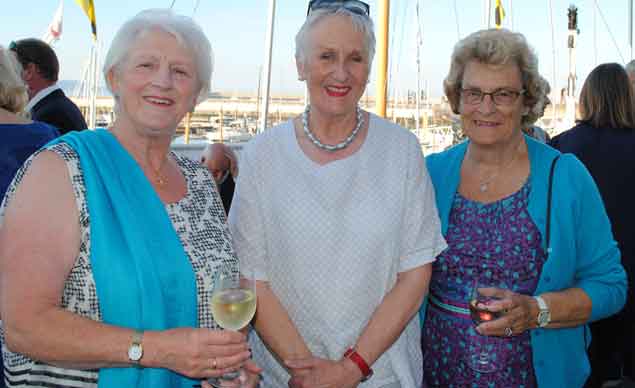 Rosemary Anderson, Barbara Cafferky and Sandra Moore
Rosemary Anderson, Barbara Cafferky and Sandra Moore
That too should see its start helped along by the summer wind. And the regatta in Dublin Bay should see racing well finished by the time the breeze slackens off in the evening, which it did last night so totally that the Water Wags Regatta Race (it’s always on the preceding Wednesday evening) could not take place. But for contenders in the Round Ireland, the big question on Saturday will be whether the underlying east to northeast gradient wind will prevail over the high summer tendency to provide a night breeze off the land.
Round Ireland Fleet Gathers in Wicklow
We’ll be looking at that and many other aspects of this well-supported event in this weekend’s Sailing on Saturday. Meanwhile, the news from Wicklow is that the diverse fleet is now gathering from near and far, and tonight a crew supper in the WSC clubhouse will provide competitors with an opportunity to put faces to names which have only been distant rivals until now.
 The early arrivals for this Saturday’s Volvo Round Ireland Race seen yesterday evening in Wicklow Harbour. Photo courtesy VRIYR
The early arrivals for this Saturday’s Volvo Round Ireland Race seen yesterday evening in Wicklow Harbour. Photo courtesy VRIYR


























